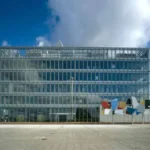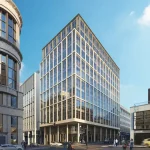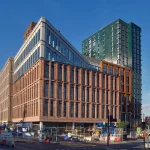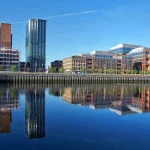Scottish Provident Edinburgh Building Debate, Former HQ on St. Andrew Square, Scotland architecture discussion
Scottish Provident Architecture Debate : Edinburgh Offices
Discussions on Current Architectural Topics

Contextual & Humane – Scottish Provident
Article by John Deffenbaugh
Scottish Provident
Scottish Provident sold its first life assurance policy in 1837, and by the late 1990s had become one of Edinburgh ’s key financial services employers, with over 900 people based in the capital. In 2000, and with much fanfare, Scottish Provident was purchased by the London-based bank Abbey, whose chief executive proclaimed ‘It’s great to be Scottish.’ Three years and approximately 700 redundancies later, the Scottish Provident brand was terminated, its business transferred to Abbey’s own operations in Glasgow.
The company’s final employees vacated its headquarters in September 2004, bring to an end over 100 years of operations on the site. Prior to this, the landmark modernist structure invigorated the south side of St. Andrew Square, in the heart of Edinburgh’s new town. During the day, its full height glazing revealed the frantic activity being carried out within, while after dark, light cascaded from the upper levels. Despite being one of the youngest buildings in the square, the Scottish Provident Building had gained the familiarity of an old friend, softening the otherwise severe formality of its traditional and contemporary neo-classical neighbours.
What has been described as ‘The finest infill building of its period in Britain,’ forms a single phase in the evolution of Scottish Provident’s sprawling complex of contemporary and classical facades on St. Andrew Square and South St. David Street. Designed by William G Leslie of the firm Rowand Anderson, Kinimonth & Paul and completed in 1969, the St. Andrew Square building constituted Phase 2 of the site’s redevelopment. Known as No 6-7 St. Andrew Square, it resides between two existing structures, No 5 St. Andrew Square, to the left, and No. 8, which turns the corner onto the square from South St. David Street, to the right. As the building was nearing completion, work began on Phase 3, a new structure located on South St. David Street adjacent to No. 8 St. Andrew Square. This was completed in 1971.
These wings shared the same powerful visual aesthetic, consisting of juxtaposed patterns of granite-clad solids and glazed voids, giving the impression of a single ‘L’ shaped building wrapping around the existing corner structure. Despite part of a larger complex, it is these wings that are commonly referred to as ‘The Scottish Provident Building.’
The main entrance to the complex is on St.Andrew Square, set within a vertical band of glazed curtain walling that runs the full height of the building. To the right of this are four projecting levels of offices. Each of these is fully glazed and framed by a narrow band of Italian granite at the sides and base. To the left of the entrance are the soaring granite masses of the stair and lift towers, providing a vertical counterpoint to the horizontality of the office levels. At ground level, the stair is clad in silicon jointed glazing, allowing the passer-by to view the building’s inhabitants travelling between floors.
Unfortunately for Scottish Provident’s employees, this external drama was not continued throughout the building’s interior, which consists for the most part of standard open plan office space. These areas were compromised by the series of internal structural columns that supported the cantilevered floor slabs, creating pockets of awkward space. Circulation proved to another problem.
Despite having the appearance of a single ‘L’ shaped structure, when viewed in plan, the two wings are in fact separate buildings, with a centrally-placed light-well. The ground level beneath this is enclosed by series of pyramidal glazed skylights that allow daylight to filter through the main foyer. While this layout avoids an overly deep floor plan and delivers the entrance experience promised by the dramatic exterior, it requires each wing to be serviced by a separate circulation core, complicating routes between offices and eating into valuable floor space.
The horizontal inflexibility of the plan is carried through vertically, in section. The concrete floor plates are unable to support the loads required by contemporary users. The maximum floor load is 4.15kN/m2, comparing unfavourably with today’s standards, which require a minimum loading of 4.35 for office use and 8.5 for retail. The structural floor-to-floor height is set at 2.85m, providing very little scope for strengthening the slabs to take any additional load. These issues came to the fore in the mid 1990s, when the complex was refurbished.
This was necessary following Scottish Provident’s expansion into the adjacent 4-5 St. Andrew Square, creating new accommodation behind the retained classical facades. Leslie’s main building was reconfigured, with the introduction of lift lobbies to meet building regulations, which together with the raised floors and suspended ceilings to accommodate new technology, further limited the upper floor office areas. At ground level, the refurbishment destroyed the quality of the entrance experience, as the main office space beneath the rear light-well was subdivided and the pyramidal skylights removed, preventing light from diffusing through the foyer. By the time it was vacated, the building served more as a circulation route to offices in neighbouring structures than as a workplace in its own right.
Recognising the building’s conservation challenges, Rannald McInnes of Historic Scotland acknowledges:
‘What we really want is an enthusiastic architect with a love of 1960s buildings, that can turn the it into a boutique hotel.’
Ian Springford, whose practice has been behind several such projects, believes this could be a realistic option.
‘While Edinburgh is reaching saturation point in terms of bed spaces, boutique hotels offer something different. The market exists and it’s a good location. If the price was right, it would it could be a great opportunity ’
However, the site is for let, not sale, discouraging the investigation of any serious reuse. This is despite Historic Scotland stating that:
‘The regulations are clear, the owner would have to put the building on the market at a price that reflects its condition and prove that there are no buyers or restoring purchasers interested.’
A further complication is Council’s desire to develop the east end of Princes Street and St. Andrew Square as a retail destination. However, Peter Cook of Abbey, who currently own the site, emphasises the need to balance the aspirations of the city council to develop the site for retail, with the needs of the listed building.
While Abbey does appear keen to explore the possibility of converting the listed building, its consultant’s activities tell a different story. CDA, architects of the adjacent Harvey Nichols, are compiling a master plan for the south side of St. Andrew’s square, with Gareth Hoskins acting as overall design architect. John McGregor, a chartered surveyor involved with the project states: ‘You would not be able to do a successful scheme on that site with that building.’
Prior to this, James Simpson, of respected conservation practice Simpson & Brown had been asked to consult on the conservation of the Scottish Provident Building. However, he states that:
‘Following our initial meeting, it was clear that they were looking for me to justify demolishing the building, which I was not prepared to do.’
Should this be the case, Edinburgh may be on the verge of losing its most contextual and humane example of twentieth century architecture. Always popular with local architects, city residents were beginning to embrace its unique charm; Mary Wilkie, an 80 year-old passer-by, stated that ‘It’s a bit dirty, but I do like it.’ If Scottish Provident cannot be saved in the heart of Edinburgh, a UNESCO world heritage site with one of highest concentrations of protected buildings in the country, there is a serious flaw in the process of listing buildings, and both myself and Mary will be very sorry to see it go.
Scottish Provident Building
Jun 2005
Texts welcome : info(at)glasgowarchitecture.co.uk
Scottish Provident Architect : William Kininmonth
Scottish Ballet
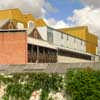
photo © Adrian Welch
Scottish Health Buildings
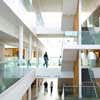
photo © Andy McGregor
Scottish National Indoor Arena
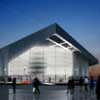
image from architects
Comments for the Scottish Provident page welcome
